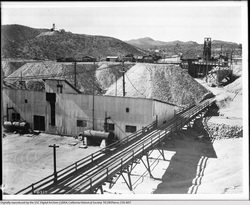Rand Mining District

Randsburg, Johannesburg and Red Mountain are three small towns along U.S. Highway 395 between Ridgecrest and Boron, California. They are the mining district towns of the Rand Area, the gold and silver mining belt of Kern County, named after the Witwatersrand of South Africa.
MINING LEGACY
The region has enjoyed a mining legacy that has played out in three stages. The 1890's witnessed the first mining frenzy and by 1900, more than $3,000,000 in gold had been extracted from the region's colorful mountain ranges. In 1905 came the tungsten boom that created the camp of Atolia. Tungsten was an essential element to the steel industry particularly when it came to making armaments, especially during both World Wars and later Korea. The last stage came in 1919, with the discovery of silver in and around what became Red Mountain.
On December 20, 1895, the Rand Mining District was organized. Twenty-six persons signed the document creating this district. Randsburg had 13 buildings at the time, mostly tents. Randsburg soon became one of the great boomtowns of the West. In fact it even enjoyed the luxury of having a neighboring town rival. In December of 1896, when Randsburg was little more than a cluster of tents, the Johannesburg Water and Townsite Company was busy laying out a rival town (Johannesburg) that would be well-planned, even to having piped water in the homes.
Johannesburg at its height had a post office, two general stores, a real estate office, stationers and variety store, billiard-pool room, music hall, boarding houses, lunch counter, two laundries, two lumber yards, two livery stables, a barber shop, telegraph line with Mojave, and a telephone exchange with Randsburg. Johannesburg built a golf course in 1900, sporting 9 greens, and had its own golf club having 13 members, 7 of them ladies.
Large-scale gold mining continued until 1918. The famous and highly productive Kelly or California Rand silver mine was discovered in 1919 and was operated on a major scale through the 1930s. Gold production from the district was substantial in the 1930s and early 1940s, and there has been intermittent prospecting and development work since. The total gold output of the district is estimated at more than $20 million.
In 2006, BLM identified dangerous levels of arsenic contamination at the Rand Mining District -- levels thousands of times higher than recognized as safe by the EPA.
